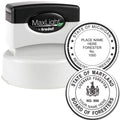Are you tired of rummaging through drawers of mismatched socks or endlessly deciphering whose shirt is whose? A clothing name stamp can simplify all that. Even if you’ve never tried labeling your family’s items, it’s worth exploring how a simple stamp can streamline everyday life. In this post, you’ll learn exactly what clothing name stamps are, why they’re so convenient, and how to pick one that’s right for you. Let’s dive in.
Understand Clothing Name Stamps
A clothing name stamp is just what it sounds like: a handy little tool for stamping names, initials, or symbols onto fabric. Think of it as your personal labeling assistant. Instead of hunting for iron-on labels or messing with a permanent marker, you simply press the stamp on your shirt collar, sock band, or sports uniform. The result is a crisp, consistent imprint that helps everyone know exactly whose item is whose.
Who Benefits From Using Them
- Families with school-aged kids who need jackets, lunch bags, and gym clothes clearly marked.
- Caregivers or people organizing clothes in retirement homes or medical facilities.
- Small business owners who want to add a brand or logo to textile products.
- Anyone who’s had enough of mixing up laundry with roommates.
How They Differ From Traditional Labels
Sure, iron-on labels and sew-in tags get the job done. But a stamp cuts down on multiple steps: there’s no ironing, sewing, or peeling. You just open an ink pad, press, and go. Many times, the ink is designed for fabric, which means it won’t fade quickly. Also, stamps are reused hundreds or even thousands of times, so you get a lot of mileage from a single purchase.
Assess Their Key Benefits
Wondering if a clothing name stamp really makes that big of a difference? It can—especially once you consider the everyday perks.
Speed and Convenience:
You can mark a week’s worth of clothes in minutes. Just line up your items, dip the stamp in ink, and press firmly.Professional Look:
Unlike a handwritten marker (which can bleed, smudge, or look messy), a stamp creates a uniform appearance. You can choose a stylish font or icon, lending an organized look to your entire wardrobe.Cost-Effective Over Time:
While you might pay a bit upfront for a quality stamp, it quickly pays for itself. One stamp can handle so many impressions that it outlasts most alternative labeling methods.Durable Markings:
Special fabric ink bonds to the textile fibers more effectively than ordinary ink. This durability means your name or brand remains readable, even after multiple washes.
Should You DIY or Buy Pre-Made?
You can craft your own stamp, but it’s often cheaper, faster, and more reliable to buy one from a reputable seller. By choosing an expert supplier, you’re ensuring your name won’t fade after two spins in the washing machine. Plus, professional makers often let you customize the text or design with fonts, symbols, or logos.
Pick the Right Stamp Type
Now that you’re thinking about using a clothing name stamp, you’ll want to settle on the right kind. Not all stamps are created equal, so let’s look at different types you might encounter.
Self-Inking vs. Pre-Inked vs. Traditional
Below is a quick comparison table showing how these three categories stack up:
| Stamp Type | Ink Delivery | Pros | Cons |
|---|---|---|---|
| Self-Inking | Built-in ink pad | Fast, convenient, fewer parts to track | Ink can dry out if neglected |
| Pre-Inked | Ink stored in stamp | Extra-crisp imprints, minimal mess | Usually higher upfront cost |
| Traditional | Separate ink pad | Stamp shape and size are very flexible | Requires extra storage for pad |
Self-Inking Stamps
Self-inking stamps feature a small ink pad inside the casing. When you press down, the rubber die touches the pad, then flips onto the fabric. These are super convenient if you need a quick, repeatable press. The main downside: you’ll need to be careful about replacing or re-inking the internal pad before it completely dries out.
Pre-Inked Stamps
Pre-inked ones hold the ink within the stamp itself. Many people love them for the sharp impression they leave. They’re also fairly mess-free since there’s no exposed ink pad. However, they can cost a bit more upfront than the other types, and you’ll need to be mindful of re-inking at the right time.
Traditional Stamps
A traditional clothes name stamp requires a separate ink pad. It’s an old-school approach, but it can be perfect if you want more control over color or if you have a specific stamp shape in mind. You do have to keep track of the extra ink pad, which some folks find cumbersome.
Explore Popular Ink Options
When you start browsing stamps, you’ll notice there’s more than one type of ink available. It’s not just about black or blue. The ink you pick determines how well your mark will hold up over time, especially through laundering.
Fabric-Safe Ink
If you’re using a fabric stamp, you’ll likely use fabric-safe ink. This style of ink is specially formulated to adhere to cloth fibers without bleeding or fading too quickly. Some will resist multiple washes, holding strong in the face of detergents or even a bit of bleach.
- Designed for all major fabric blends.
- Often comes in subtle colors like black or navy for easy readability.
- Typically dries quickly, so you can move on to the next item right away.
Permanent Ink
Permanent inks are meant to stay vivid for a long time. They’re sometimes used on other materials like paper, cardboard, or even wood, but a well-chosen brand can also work on clothing. Keep in mind that not all permanent inks are created for fabric, so make sure you confirm that detail with your stamp supplier.
Quick-Dry Ink
No time to let your stamps set? Quick-dry ink might be your favorite. It tends to evaporate rapidly upon contact, so you need to move fast and steady when stamping. This is ideal if you’re stamping large volumes of shirts or uniforms and don’t want to risk smudging.
Common Worries About Ink Safety
You might wonder if the ink is safe for your youngster’s clothes or for sensitive skin types. Generally, stamping ink is non-toxic, but always double-check manufacturer details. If you’re uncertain, look for an ink labeled as non-toxic or certified for children’s products.
Find the Best Supplier
Choosing the right stamp is only part of the story. You also want a great supplier, one that stands behind its product and provides stellar customer service. That’s where ESS comes in. As a family-owned business since 1964, ESS has a 60-year legacy of serving customers with top-notch clothing name stamps, fabric stamps, and more.
What Makes a Supplier Stand Out
- Experience: A brand like ESS has decades of hands-on know-how. Their team has seen every stamping scenario imaginable, so they can help you troubleshoot issues if they arise.
- Quality Products: Not all stamps and inks pass the same durability tests. Look for a supplier that offers top-quality materials, ensuring each impression on your clothes stays crisp and clear.
- Fast Turnaround: Nobody wants to wait weeks for a custom name stamp. ESS prioritizes getting your order out quickly, which is a lifesaver if you’re rushing to label school uniforms or sports gear.
- Customization Options: Maybe you want a little heart icon next to your child’s name. Or perhaps you want a corporate logo for your small business. A good supplier will offer plenty of customization choices.
Why Customer Service Matters
Good customer service means more than just an email reply. It’s about genuine help when you have trouble. If your ink doesn’t print as expected, you want a quick resolution. If you’ve never used a clothing name stamp before, you might need basic instructions. A responsive, friendly contact can save you time and frustration.
Care for Your Stamp
So, you’ve found a stamp style that suits you, chosen the ink, and lined up a supplier. What now? Take some time to learn how to care for your clothing name stamp. These little steps extend its life and improve the clarity of every impression.
Cleaning and Storage Tips
Wipe Off Excess Ink:
After each stamping session, gently dab off any remaining ink on the stamp face. Use a soft cloth or paper towel. This keeps your lines crisp and prevents build-up.Use a Mild Cleaner:
Occasionally, a mild soapy solution helps remove dried film or lint from the stamp’s surface. Avoid harsh chemicals that might erode the stamping material.Keep It Covered:
If you have a self-inking or pre-inked stamp, store it with the lid closed. This prevents dust from settling in and slows down the ink’s evaporation rate.Re-Ink Promptly:
Keep an eye on your impressions. If they look faint or incomplete, add new ink right away. That way, you avoid any risk of damaging the rubber portion by pressing too hard.
Maintaining Ink Pads
For those with traditional stamps, caring for the separate ink pad matters just as much:
- Store your ink pad in an airtight container if possible.
- Avoid direct sunlight or extreme temperatures.
- When re-inking, distribute the refill fluid evenly, then wait a few minutes before using.
Review Common Questions
Here are some of the questions people often ask when they’re first getting into clothing name stamping. If you’ve had one of these thoughts yourself, you’re definitely not alone.
How Do I Prevent Ink From Bleeding On Fabric?
Most fabric-safe inks are designed to minimize bleeding, but you can also test the stamp on a small, hidden area first. Let the ink dry fully (usually a few minutes) before wearing or washing the item. If you notice any slight spread, consider using a quick-dry or permanent ink formulated specifically for porous materials.-
How Long Does a Clothing Name Stamp Last?
With proper care, a clothing name stamp can last for several years or thousands of impressions. The rubber surface eventually wears down, but you’ll likely get more than enough usage before you need a replacement. And if you keep your ink pad or ink reservoir in good shape, the imprint remains clear each time. Can I Stamp On Dark Fabrics?
You can, but you may want a lighter ink color or a special opaque fabric ink for the best visibility. Some suppliers carry white or metallic ink, which can show up on dark colors like black or navy. The key is to check that the ink you’re buying is suited for dark fabric printing.Is a Clothing Name Stamp Safe for Children’s Items?
Yes. In most cases, a good clothing name stamp uses non-toxic ink that’s safe for kids’ clothes, blankets, and other accessories. Still, it’s wise to purchase from a reputable brand like ESS, which prioritizes safe, high-quality materials.Will the Stamp Fade After Washing?
Fabric-safe or permanent inks typically hold up well in the wash, especially when you follow the recommended after-stamping instructions. Colors may lighten a bit over time, but you should still see a legible name for plenty of laundry cycles. If you need more longevity, top-tier suppliers offer premium inks that can handle extra scrubbing or heavy-duty detergents.
Wrap-Up and Next Steps
Choosing the right clothing name stamp might feel a bit overwhelming at first, but focusing on a few key elements—type of stamp, ink safety, and supplier reputation—simplifies the decision. It’s all about setting yourself up with a reliable, budget-friendly way to keep your wardrobe neatly identified. Whether you’re labeling kids’ uniforms, small-business merchandise, or personal items for travel or shared living spaces, a study-backed stamp can save you time and hassle.
Ready to get started? Explore the different stamp types (self-inking, pre-inked, or traditional) and pick an ink designed specifically for fabrics. If you want a trusted supplier, consider ESS. Family owned since 1964 and known for stellar customer service, ESS offers a range of clothes marking options, custom designs, and super-fast turnaround. No matter your needs—school, sports camp, personal branding—you can stamp, wash, and repeat, knowing your markings will stay sharp for the long haul.
If you still have questions, reach out to a reputable stamp maker or poke around online reviews for real-user insights. You’ll be surprised how quickly these stamps become part of your daily routine. Then, when laundry day rolls around, you’ll be grateful for those neatly labeled shirts, socks, and everything in between. Happy stamping!


















